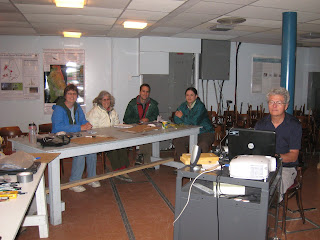Mrs. Kraft's Blog
permafrost

Saturday, July 31, 2010
Sunday, July 4, 2010
What do I expect to be the primary benefits to my peers, my students, my colleagues, my friends, and myself?
The entire experience was unbelievable. The research, although tedious at times, proved to be fun. I am going to encourage my fellow teachers to apply for similar expeditions. My excitement about sharing what I have learned with my students hopefully will teach them that science is more than experiments and textbooks. Science surrounds us everyday. A major benefit for my colleagues is the opportunity to share ideas and expertise with each other. I hope we always remember the thrill of riding the Zodiak onto and standing on the ice floe in the Hudson Bay!! What an experience!
Has the project in any way changed my approach to teaching or learning?
One eye opener I had was how difficult it was to follow a lecture if I was unfamiliar with the vocabulary. As an educated adult I sometimes forget that my students do not always understand all of the terms pertinent to the topic under study. Although our presenter thoroughly enjoys his research, his enthusiasm did not always transfer to me as I listened to his evening lectures. Granted, I was tired by 7:30pm after spending 7 hours in the field, but my interest in the topic might have been sustained if I was more familiar with pingos. polygonal peat plateuas, and palsas.
During the course of the study I did learn that a pingo is a mound of gravel or earth occuring inn Arctic regions as a result of pressure from water ttrapped between newly frozen ice and the permafrost beneath it. A palsa is in an area of permafrost, a peat mound, several metres in height, and up to 100 m in diameter, which obtrudes because it is better drained and thus more subject to frost heaving than wetter areas.
In retrospect, I know I need to stress the vocabulary of scientific terms more than I have in the past. My challenge will be to keep my students interested in science at the same time.
During the course of the study I did learn that a pingo is a mound of gravel or earth occuring inn Arctic regions as a result of pressure from water ttrapped between newly frozen ice and the permafrost beneath it. A palsa is in an area of permafrost, a peat mound, several metres in height, and up to 100 m in diameter, which obtrudes because it is better drained and thus more subject to frost heaving than wetter areas.
In retrospect, I know I need to stress the vocabulary of scientific terms more than I have in the past. My challenge will be to keep my students interested in science at the same time.
Related articles by Zemanta
- For Global Warming, Tundra Fires' Effects May Be Skin Deep (news.sciencemag.org)
What has the experience taught me about scientific research and conservation?
Scientific research does not have to be conducted in a well equipped lab. I need to expose my students to more investigations outdoors. If I truly desire to instill a sense of responsibility for the environment within them, I need to provide as much exposure to the natural world as possible. These experiences can be as close as the school yard. I am fortunate that our school sits on at least 10 acres and has open and wooded areas.
Saturday, July 3, 2010
What skills did I learn?
Before the trip I was not comfortable blogging and utilizing internet networking but my team members enthusiastically encouraged all of us to engage in these activities. I now believe that I will try to incorporate a blog into my communication options with my students and their families. I also learned that I must stress with my students the importance of being able to work within a group, large and small. It is vital that they are able to listen to each other's opinions and ideas.
How does the research in Churchill and what I learned relate to me and my local community?
Like many others, I often forget that my actions and decisions have global consequences. My choice of vehicle to drive, the cleaners I use, even the type of lightbulbs I burn all effect the global climate. Maybe not individually, but aggregately with the rest of the world population. It is my hope to discover if an environmental ethic can be instilled in adolescents even if they do not feel a personal connection with nature.
How will I bring the experience home?

Last year my students and I learned science through an interactive unit about Antarctica. This year I plan on integrating my experiences in Oslo, Norway and in Churchill, Manitoba into a unit about both poles. The majority of our curriculum can be addressed through polar science. Concepts of erosion, glaciation, weather, climate, genetics, classification, and matter all connect to the Arctic and to Antarctica.
Teachers at the conference in Norway and those on the Churchill expedition enlightened me with abundant ideas for use with my students. Some of the Earthwatch educators and I plan to replicate the Dr. Kershaw's study with their middle school students in their school environment. My students and I will also monitor seasonal sightings of migratory birds in our local area in order to track indications of climate change.
Subscribe to:
Comments (Atom)






